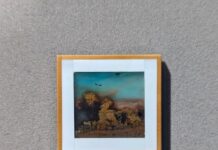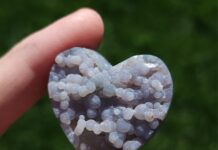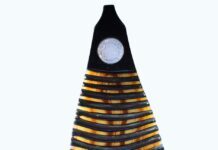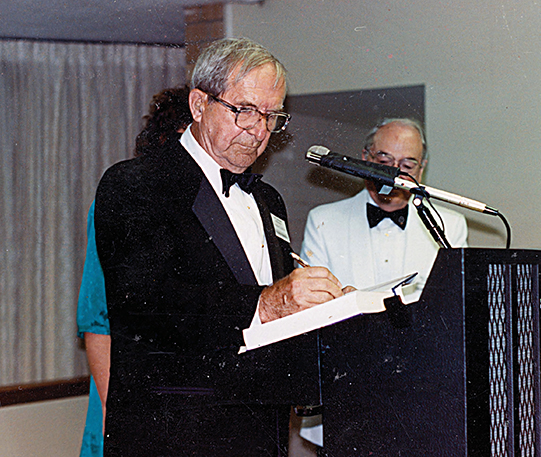
By Bob Jones
During the 80 odd years I’ve enjoyed an extensive appreciation of minerals, I’ve had the good fortune to meet thousands of mineral collectors and lapidaries. I’ve become friendly with hundreds of professionals in the gem and mineral world, including curators of many major mineral museums and universities in America, Europe, and beyond. Among this vast group are individuals who profoundly influenced me and the science and hobby of mineral collecting.
Within this group of inspiring people, John Sinkankas ranks above all. Dr. John Sinkankas was not only a good friend but a mentor who had the most substantial influence on me in terms of mineral activities. For the science and hobby, John undoubtedly made a more significant contribution to amateur mineral collecting than anyone else I know. He was a skilled writer-teacher whose writings on complex mineral subjects made them understandable to the average rockhound.
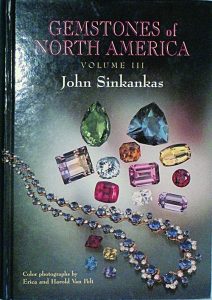
Many a mineral collector and lapidary artist can attest to learning a great deal from various books he’s written about minerals, gem cutting, and the lapidary arts. Additionally, he also wrote field guides on mineral collecting and prospecting and a series of catalogs providing data minerals and gem materials. He began his writing career in 1951, with a column about amateur lapidary. Then in 1964, he penned the history-making text, Mineralogy for Amateurs. The book made the science of mineralogy more accessible and understandable, and as such, became a popular choice for college syllabuses everywhere. He followed this with many other books including, Emeralds and Other Beryls, which combined his interest in gems and minerals and his strong interest and investigation of pegmatite deposits.
INSPIRED TO EDUCATE
Since he lived in Southern California, it was only logical that he spent day after day digging and investigating its famous pegmatite deposits. This practice partially inspired one of his most famous writings, the two-volume work, Gemstones of North America. Volume one was published in 1959, followed in 1976 by volume two. When John gave me a copy of the second volume, he inscribed it as follows: “I inscribe this with my sincerest regards for all you have done to make our hobby the most interesting!” This inscription was typical of John’s support and encouragement.
I met John and his lovely wife, Marge, in 1961, shortly after he completed his military service in naval aviation. As an active collector, he lectured at major shows like Tucson, Pasadena, the Federation Shows, and local club shows where we became friends. By the 1970s, we were writing for the new magazine Rock & Gem, when it started in 1971. By that time, John was also familiar with my column in Rocks & Minerals magazine, which at the time was struggling to survive. The magazine was available for purchase, and John had hopes of keeping it alive. He organized a small group hoping to take over Rocks & Minerals magazine and called me to ask if I would be willing to serve as the editor of Rocks & Minerals if they took over. I had no interest in doing that but was grateful that John considered me. My friend Marie Huizing became its editor and, to this day, continues to do a great job.
On many occasions over the years, I would visit John and Marge in San Diego. During frequent trips to visit family in the area, I’d stop in for a visit. Since John was a bibliophile, he had an excellent and extensive library of mineral and gem books and articles. At other times, when I was researching a particular subject, they would invite me to spend a week with them to do my work. I think I learned as much from John over lunch each day than from his library because his interests spanned the entire spectrum of gems and minerals.
LIVING LIFE TO THE FULLEST
John’s vast interest in gems and minerals began at an early age. A native of
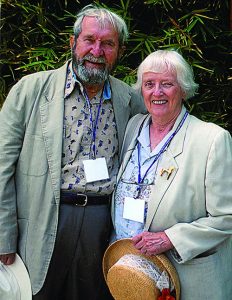
Paterson, New Jersey, a very active area for rockhounding, by the time he was seven years of age, John enjoyed his first collecting trip, where the goal was to locate zeolites, which he did.
His other passion was flying. I find it remarkable that John pursued this interest so intensely that he built a large glider and flew it as a teenager. This early interest led to a career as a pilot in the U.S. Navy. It began with him graduating in 1937 from Pensacola Naval Air Station before world War II, followed by John and Marge marrying just a few years after military graduation.
As impressive as was his knowledge and contributions to mineralogy, John’s military service was equally so. During World War II, he flew the very dependable Consolidated PBY Catalina seaplane, flying anti-submarine patrols off the coasts of the U.S. Eventually, he was appointed Commanding Officer of the Patrol Plane Training squadron. As a pilot, he participated in the Aleutian Islands campaign against the Japanese. He also often piloted high ranking officers to various destinations, including Greenland, where he also found time and opportunity to collect minerals.
Although many may be familiar with John’s contributions as an author, he was just as much an active collector, who specialized in pegmatite deposits. He also focused on gemology and faceting, and he served as co-operator, with his wife Marge, of a rare book company called Peri Lithon. The company’s name was the same as the title of the first book ever written about minerals, by Greek Theophrastus, in about 400 B.C.
Earlier I mentioned using John’s library at his home. He had converted his two-car garage at his home in San Diego by building rows of shelving. He stored many books, articles, papers, and magazines about gems, minerals, mines, and localities within the library. Each item was cross-cataloged, creating a rare font of gem and mineral knowledge. His library was so superior that it was purchased by the Gemological Institute of America (www.gia.org), one of the world’s leading educational and research institutes.
These many accomplishments did not go unnoticed by his alma mater. In 1984, John’s work in mineralogy earned him an honorary Ph.D. in Mineralogy. That same year a new mineral was named in his honor, sinkankasite, to recognize John’s significant contributions to science and the hobby. The mineral that would be named sinkankasite was discovered during a study of the phosphate minerals at the pegmatite deposit of Keystone, South Dakota.
ACCOLADES AND HONORS
The mineral is as complex as its namesake — a hydrous hydrate of hydrogen, manganese, aluminum phosphate. It forms monoclinic crystals that are very small, which probably pleased John, as he was a devoted micro-mounter! The mineral was also found among the phosphates at the equally noteworthy Palermo Pegmatite, North Groton, NH.
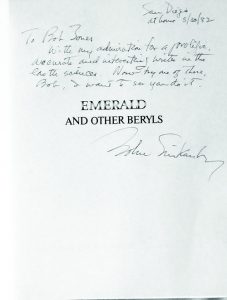
BOB JONES
In terms of faceting, John was exceptionally skillful, so much so he was invited by the Smithsonian and other institutions to create small collections of enormous faceted gems. Another noteworthy faceting request was for the Smithsonian, in which he faceted 4,500-carat smoky quartz, 2,054-carat golden beryl, a 3,373-carat blue topaz, and an 1800 carat spodumene. He did equally large faceted gems for the American Museum of Natural History, New York, and the Carnegie Museum in Pittsburgh. To create these massive pieces, John had to construct a faceting machine to handle these large gems! For the Smithsonian, he also designed and created a stunning 7,000-carat faceted quarts egg resting on golden spikes tipped with sapphires and Arkansas faceted diamonds!
The funniest story I ever heard about the Smithsonian large gems, including those done by John, happened at a Federation Show in Florida. The Smithsonian’s Curator Paul Desautels had been invited to bring a display. When he arrived, show officials were confused as it seemed he was empty-handed. However, after being escorted to the display case, he took several huge and highly-valuable faceted gems out of his coat pockets. It seemed he had flown from D.C. to Florida with the gems in his coat pockets, knowing who would be the wiser! Paul did the same thing with the Smithsonian’s inquisition necklace, which I later hid under my mattress and slept on before returning it to the Smithsonian. Again, who was the wiser?
As a lecturer, John was a skillful teacher. I recall a talk wherein John explained why precious opal had the play-of-colors. The discussion took place not long after the actual cause of this phenomenon had been discovered. When introduced, John came to the stage, holding an open cardboard box containing a pile of small oranges. He set it down and began to speak. When John got to the subject of what causes the array of colors in precious opal, he picked up the box of oranges. He arranged them in a very orderly parallel display — a perfect visual image of what cristobalite diffraction grating looked like inside a precious opal. Everyone in the audience immediately understood the concept.
Besides having a mineral named after him and receiving an honorary doctorate, John received various awards and accolades for his contributions to the science and hobby of mineralogy. He became a fellow in the Gemological Society of America and a fellow in the Mineralogical Society of America. Plus, in 1982, he was made a distinguished associate of the Gemological Institute of America.
As important as these professional awards are, the honor that seems to recognize best John’s contributions to education and knowledge of mineralogy for amateur collectors is the Carnegie Mineralogical Award. This prestigious award was developed in the late 1980s by the Carnegie organization connected to the Carnegie Gem and Mineral Museum in Pittsburgh. The first such award was presented at the Tucson Show in 1988 and given to the Tucson Gem and Mineral Society for 30 years of promoting and hosting what is still the single most important gem and mineral show in the world.
The following year, 1989, Carnegie began recognizing individuals for their important and significant contributions to education and promoting the science of Mineralogy. It was only right and proper the first Carnegie Mineralogical Award for an individual be Dr. John Sinkankas! He was an obvious first choice and much deserved. Since that year, many individuals and some organizations have been given the award. I was fortunate to receive the Carnegie Mineralogical Award ten years after John! When I was given the award at a banquet in Tucson, I must confess that I took that opportunity to prose to my future wife Carol in front of 250 rockhounds! How could she refuse?
This general summary of the contributions of the late John Sinkankas, who died in 2002, may help more people understand the impact and effect he had on mineralogy elements. Personally, John’s mentorship and encouragement to pursue my interest in writing certainly helped me. His writing is timeless. You can search the internet to find copies of his books or contact Rocks of Ages (www.rxofages.com), the bookseller that followed Peri Lithon.


